Incredible Sauce for Beef, Lamb, Chicken or Duck
Rosemary peppercorn sauce made with demi-glace is a luxurious and flavorful addition to various dishes, particularly meats such as steak, lamb, or pork. This sauce combines the robust, earthy flavors of rosemary with the sharp, spicy kick of peppercorns, all enveloped in the rich, deep essence of demi-glace.
Demi-glace is a classic French sauce that serves as a foundation for many other sauces. It is made by simmering beef or veal stock and brown sauce (Espagnole) together until it reduces to a thick, intensely flavored glaze. This reduction process enhances the sauce’s complexity and richness, making it an ideal base for the rosemary peppercorn sauce.
To prepare rosemary peppercorn sauce, start by finely chopping fresh rosemary leaves and lightly crushing whole peppercorns. The choice of peppercorns can vary; black, green, or pink peppercorns each contribute unique flavors and levels of spiciness to the sauce. Black peppercorns provide a robust heat, while green and pink peppercorns add milder, fruitier notes.
Begin by heating a small amount of oil or butter in a saucepan over medium heat. Sauté the chopped rosemary and crushed peppercorns briefly to release their aromas. Then, add the demi-glace and bring the mixture to a gentle simmer. Allow the sauce to reduce slightly, enhancing the integration of flavors. For added depth, a splash of red wine or a dollop of Dijon mustard can be incorporated during the simmering process.
Once the sauce has reached the desired consistency, it should be smooth and glossy. Strain the sauce to remove any solids, ensuring a velvety texture. The resulting rosemary peppercorn sauce is an exquisite blend of herbal and peppery notes, balanced by the rich, umami undertones of the demi-glace. This sauce elevates any dish it accompanies, adding a sophisticated touch to your culinary creations.
History
The history of rosemary peppercorn sauce with demi-glace is not as well-documented as some other classic sauces, but its roots can be traced to the traditions of French cuisine, particularly in the use of demi-glace as a foundational element. Demi-glace itself is a cornerstone of French culinary tradition, originating from the kitchens of classic French chefs like Auguste Escoffier in the 19th century. Escoffier’s work in codifying and refining French sauces laid the groundwork for many modern variations, including those incorporating herbs and spices like rosemary and peppercorns.
Rosemary has a long history in Mediterranean cuisine, prized for its aromatic and medicinal properties. It was used by the ancient Greeks and Romans and has remained a staple in European cooking for centuries. Similarly, peppercorns have been valued for their flavor and preservative qualities, playing a significant role in the spice trade and European cuisine since the Middle Ages.
The combination of rosemary and peppercorns likely evolved in more contemporary kitchens as chefs experimented with pairing these robust, complementary flavors. The pairing of these ingredients with demi-glace leverages the sauce’s rich, concentrated base, allowing the herbal and spicy notes to shine without overwhelming the palate.
This sauce exemplifies the French culinary philosophy of balancing rich, complex flavors with fresh, aromatic ingredients. Over time, this sauce has become popular in gourmet kitchens and upscale restaurants, where chefs continue to innovate by blending classic techniques with modern flavor profiles.
In essence, while rosemary peppercorn sauce with demi-glace may not have a singular origin story, it is a product of centuries of culinary evolution, marrying traditional French techniques with the timeless appeal of rosemary and peppercorns. This sauce represents the ongoing dialogue between classic and contemporary cooking, reflecting the dynamic nature of culinary art.
Rosemary: (Rosmarinus officinalis) is an aromatic herb with needle-like leaves that belongs to the mint family, Lamiaceae. It is native to the Mediterranean region but is now cultivated in many parts of the world. Rosemary is known for its distinctive fragrance, flavorful leaves, and various culinary and medicinal uses.
Its name is derived from the Latin word rosmarinus, meaning “dew of the sea,” because it was found growing near the ocean. Rosemary can grow as high as six feet. It sports tiny flowers which can be a myriad of colors such as white, blue, purple or pink. The edible leaves have a bittersweet, lemony, and piney flavor.
Shallots: Shallots are a type of onion that belongs to the Allium family, which also includes garlic, onions, and leeks. They have a milder and sweeter flavor compared to regular onions, making them a popular choice in various culinary dishes. Shallots are characterized by their small size, elongated shape, and thin, coppery-brown papery skin.
Peppercorn Rosemary Sauce Recipe
Ingredients
- 1 cup demi glace
- 1 tablespoon fresh rosemary finely chopped
- 1 tablespoon whole peppercorns black, green or mixed, lightly crushed
- 1 tablespoon butter
- 1 small shallot finely minced
- ¼ cup red wine
- 1 teaspoon Dijon mustard for added flavor
- salt to taste
Instructions
- Finely chop the fresh rosemary.
- Lightly crush the whole peppercorns using a mortar and pestle or the back of a spoon.
- Mince the shallot finely.
- In a medium saucepan, melt the butter over medium heat.
- Add the minced shallot and sauté until softened and translucent, about 2-3 minutes.
- Add the chopped rosemary and crushed peppercorns to the saucepan. Sauté for another 1-2 minutes, until fragrant.
- Add the red wine into the pan to deglaze, scraping up any browned bits from the bottom. Allow the wine to reduce by half, about 3-4 minutes.
- Pour in the demi-glace, stirring to combine with the aromatics and reduced wine. Bring the mixture to a gentle simmer over medium-low heat.
- Stir in the Dijon mustard, blending it well into the sauce.
- Let the sauce simmer gently, allowing it to reduce and thicken slightly. This should take about 5-10 minutes. Stir occasionally to prevent sticking and ensure even cooking.
- Taste the sauce and season with salt if needed.
- Strain the sauce through a fine-mesh sieve to remove the solids for a smooth texture. Optional
- The rosemary peppercorn sauce is now ready to be served. Drizzle it over your favorite meats, such as steak, lamb, or pork.

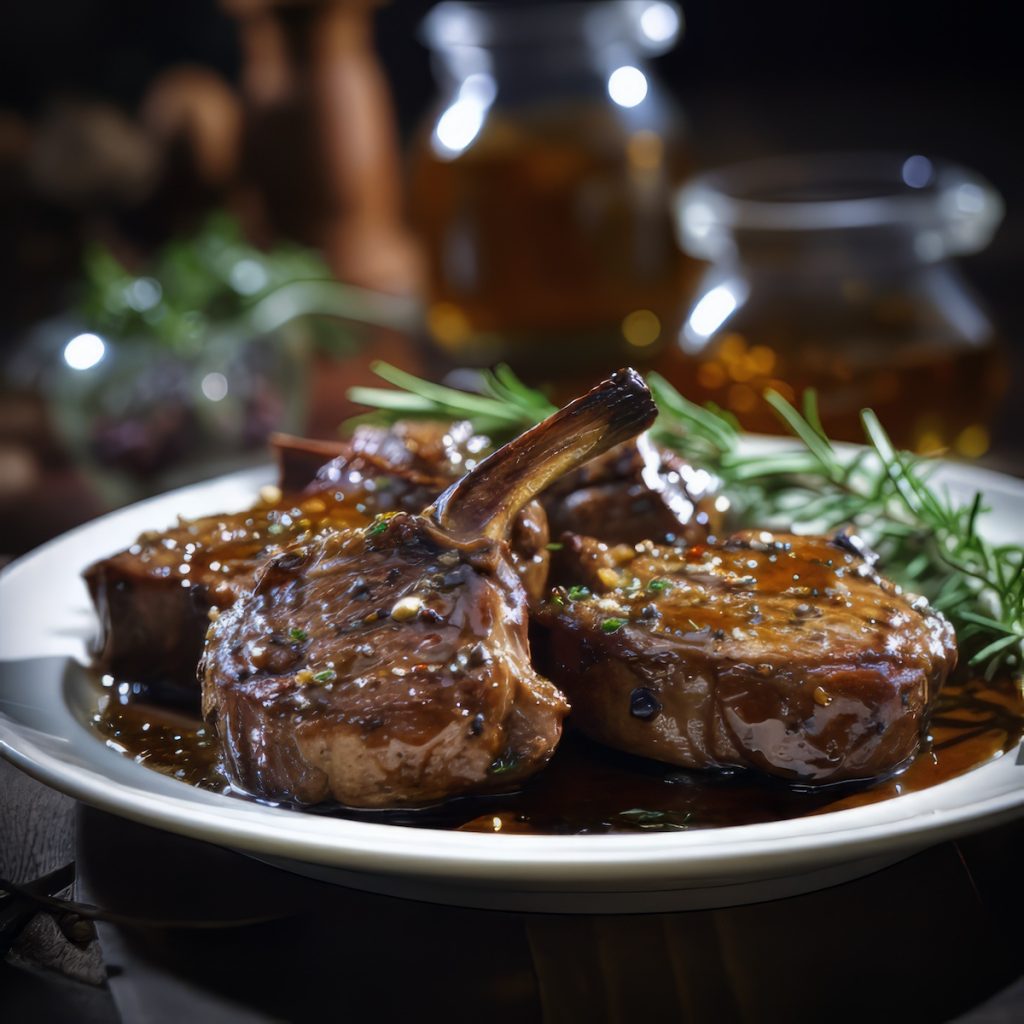
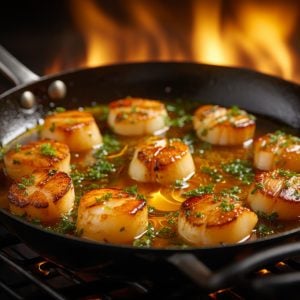
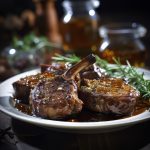
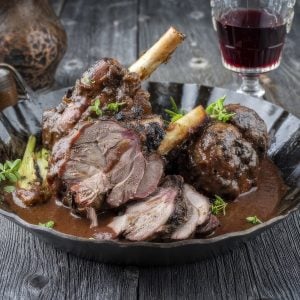
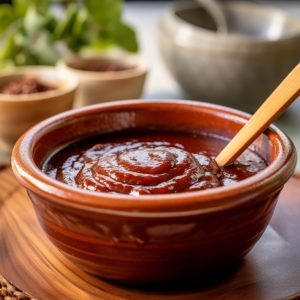
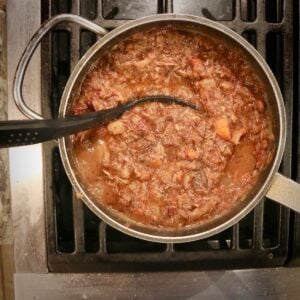
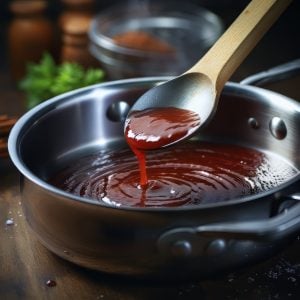
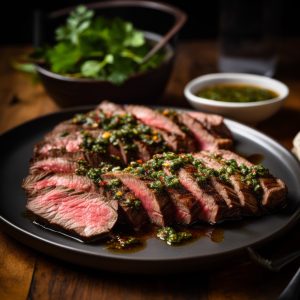
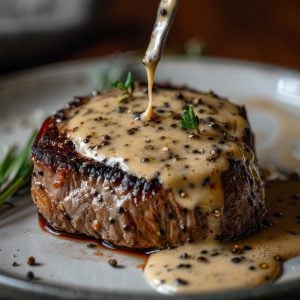
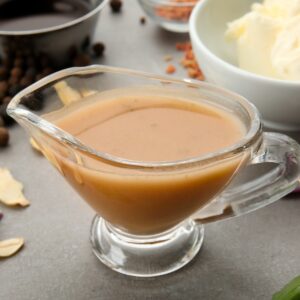
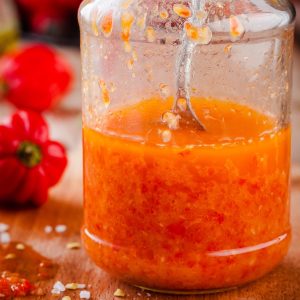


3 Responses
Do you REALLY mean 8 oz. of demi-glace? That seems like a huge amount. I would expect something more like 2-3 T.
Bill, this recipe is for making 1 cup of rosemary peppercorn sauce so you need 1 cup of demi glace. If you are thinking about using a product like More Than Gourmet’s Demi Glace Gold that gets reconstituted with water, you are correct. You would use approximately 1 1/2 ounces of the demi glace reduction and reconstitute it with 8 ounces of water. Hope that helps.
Very interesting looking forward to more tips.